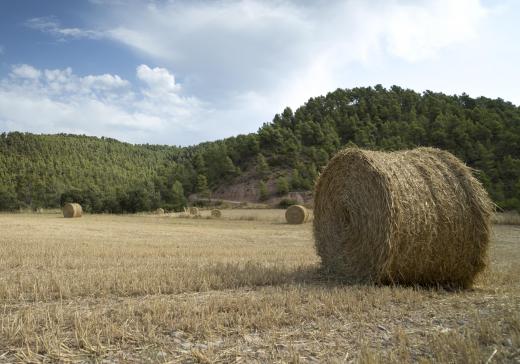There are several groups of round baler parts, from the pickup to the main frame. Rollers, gathering teeth and belts make up some of the more important round baler parts. Some of the less noticeable, yet important, round baler parts are the wheels, twine rollers and the hydraulic cylinders. Other key parts include the chassis, hitch and drive shaft.
A round baler is a device that is towed behind a tractor and makes large, round bales of feed and bedding by gathering crops that have been cut down and allowed to dry off in the wind and sun. The round baler has no power plant of its own. The baler receives power from the tractor in the form of a power takeoff (PTO) shaft that is coupled to the tractor. A small shaft emerging from the rear of the tractor, just above the hitch, is powered from the tractor's transmission. The PTO shaft, one of the round baler parts, is coupled to this shaft and sends power from the tractor to the baler.

Some of the internal round baler parts that are responsible for making the round bale are the pickup teeth and the teeth guides. These teeth are long, wire-like devices that spin inside the teeth guides and pick up the crop and direct it towards the inner area of the baler. There are several parts that work in unison to pick up the crop, and all of these round baler parts are operating off of the PTO unit. The crops are directed towards other parts, such as large belts that start the crops tumbling in a motion that begins the center section of the round bale. Large rollers are mounted on hydraulic cylinders and ride in tracks that allow the tension to be set and the bale to be tightened up as it tumbles.
As more and more crop material enters the pickup teeth and joins the tumbling bale, the bale is grown and begins to take up more space inside the baler chassis. When the bale reaches the optimum size, an indicator roller is triggered and a sensor sends a signal to a light mounted inside the tractor's cab indicating the bale has reached the desired size. The operator then activates a string roller, which causes the bale to spin and wind twine around the bale, effectively tying it off. The twine is cut by round baler parts known as knives, and the operator then empties the bale from the baler.
